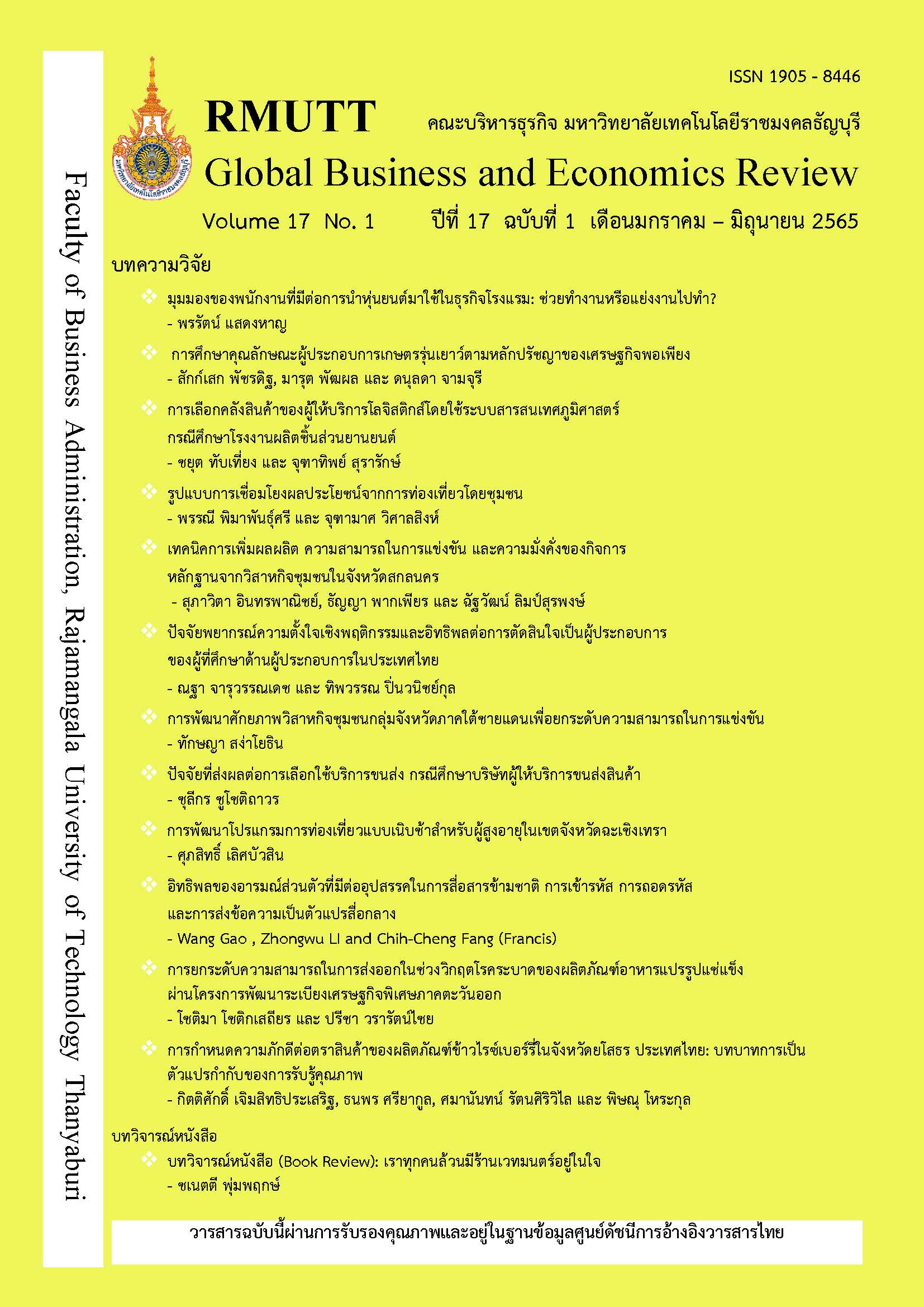การพัฒนาศักยภาพวิสาหกิจชุมชนกลุ่มจังหวัดภาคใต้ชายแดนเพื่อยกระดับความสามารถในการแข่งขัน
คำสำคัญ:
วิสาหกิจชุมชน , กลุ่มจังหวัดภาคใต้ชายแดน , การพัฒนาศักยภาพ , ความสามารถในการแข่งขันบทคัดย่อ
การวิจัยนี้มีวัตถุประสงค์เพื่อวิเคราะห์ปัญหาของวิสาหกิจชุมชนจังหวัดภาคใต้ชายแดน และเสนอแนวทางพัฒนาศักยภาพวิสาหกิจชุมชนจังหวัดภาคใต้ชายแดน เพื่อยกระดับความสามารถในการแข่งขันเป็นวิธีการวิจัยเชิงคุณภาพด้วยการสัมภาษณ์เชิงลึกจากกลุ่มประชากรได้แก่ ผู้ประกอบการวิสาหกิจชุมชนและบุคคลภายนอกในมุมมอง โดยศึกษาพื้นที่กลุ่มจังหวัดภาคใต้ชายแดนของประเทศไทย ผลการวิจัย พบว่า การดำเนินงานของวิสาหกิจชุมชนกลุ่มจังหวัดภาคใต้ชายแดน มีปัญหาที่พบในด้านการผลิตที่ขาดแคลนแรงงานและเทคโนโลยีในการผลิต ขาดความรู้ด้านการตลาดในการทำตลาดออนไลน์และการพัฒนาผลิตภัณฑ์รวมถึงการเพิ่มช่องทางการจัดจำหน่าย ด้านการเงินและบัญชียังไม่มีระบบการคิดต้นทุนที่ถูกต้องรวมถึงปัญหาการเข้าถึงแหล่งเงินทุน ขาดความรู้ทางด้านการบริหารและการปรับทัศนคติของสมาชิกให้ยอมรับการเปลี่ยนแปลง ขาดการมีส่วนร่วมของเครือข่าย การแก้ปัญหาโดยยกระดับความสามารถในการแข่งขัน ด้านปัจจัยการผลิต ควรให้ความรู้และทักษะที่จำเป็นในการพัฒนา ส่งเสริมการมีภาวะผู้นำให้กับสมาชิก ด้านอุปสงค์ต้องทำการผลิตสินค้าให้ตรงกับความต้องการของผู้บริโภค พัฒนาตราสินค้าให้มีความโดดเด่น ด้านอุตสาหกรรมที่เกี่ยวข้อง ต้องหาความร่วมมือทางเครือข่ายโดยการสร้างระบบนิเวศทางธุรกิจ ปัจจัยด้านกลยุทธ์ โครงสร้างและการแข่งขัน ทำการดึงจุดเด่นในการทำตลาดออนไลน์และการสร้างนวัตกรรมในการสื่อสารผ่านแพลทฟอร์ม มีกระบวนการเล่าเรื่องที่สะท้อนเอกลักษณ์และภูมิปัญญาท้องถิ่น สร้างเศรษฐกิจสร้างสรรค์ให้เกิดขึ้นในพื้นที่ ภาครัฐต้องให้การสนับสนุนทุกด้านที่เป็นประโยชน์ และต้องนำโอกาสที่เกิดขึ้นมาร่วมพัฒนา ดึงมุมมองคนนอกพื้นที่เข้ามาร่วมพัฒนาสร้างความเป็นมืออาชีพและความยั่งยืนให้เกิดขึ้นกับวิสาหกิจชุมชน
References
Allio, R. T., & Fahey, L. (2012). Joan magretta: what executive can learn from revisiting Michael Porter. Strategy & Leadership, 40(2), 5-10.
Astara, W. W., Budiartha, N. P., & Wesna, A. S. (2020). Legal politic of tourism village management based on local wisdom value of Pancalila’s legal ideals. International Journal of Entrepreneurship, 24(5). Retriveved from https://www.abacademies.org/articles/legal-politic-of-tourism-village-management-based-on-local-wisdom-value-of-pancasilas-legal-ideals-9853.html
Banalieva, E. R., Eddleston, K. A., & Zellweger, T. M. (2015). When do family firms have an advantage in transitioning economies? Toward a dynamic institution-based view. Strategic Management Journal, 36, 1358-1377.
Barrett, R. (2010). The importance of values in builging a high - performance culture. Retrieved from https://www.valuescentre.com/wp-content/uploads/PDF_ Resources/Additional_Articles/Article_Importance_of_Values.pdf
Batarliene, N., Ciziuniene, K., Vaiciute, K., Sapalaite, I., & Jarasuniene, A. (2017). The impact of human resource management on the competitiveness of transport companies. Procedia Engineering, 187, 110-116.
Carmeli, A., Zivan, I., Gomes, E., & Markman, G.D. (2017). Underlining micro socio-psychological mechanisms of buyer-supplier relationships: Implications for inter-organizational learning agility. Human Resource Management Review, 31(3). https://doi.org/10.1016/j.hrmr.2016.12.002
Creech, H., Paas, L., Gabriel, G. H., Voora, V., Hybsier, C., & Marquard, H. (2014). Small-scale social-environmental enterprises in the green economy: Supporting grassroots innovation. Development in Practice, 24(3), 366-378.
Doligalski, T., Zaborek, P., & Romanczuk, S. S. (2015). Vaalue proposition and firm performance: segmentation of polish online companies. International Journal of Business Performance Management, 27(1), 66-82.
Holttinen, H. (2014). Contextualizing value propositions: examining how consumers experience value propositions in their practices. Australasian Marketing Journal, 22(2), 103-110.
Koenigsfed, N. J. (2018). Role of these two factors can help managers in governmental organizations to pay more attention to the leadership styles applied in these organizations, organizational evolution – how digital disruption enforces organizational Agility. IFAC – Papers Online, 51(30), 486-491.
Mohiuddin, K. G. B., Gordon, R., Magee, C., & Lee, J. K. (2016). A conceptual framework of call for social marketing. Journal of Social Marketing, 6(2), 121-143.
National Strategic Plan Committee. (2018). The 20-year national strategy from 2017 – 2036. Retrieved from https://www.thaitribune.org/ contents/ detail/ 302?content_id=29691&rand=1506659875. (In Thai)
Porter, M. E. (1998). On competition. Boss Ton: Harvard Business School.
Pourzakarya, M., & Bahramjerdi, S. F. N. (2019). Towards developing a cultural and creative quarter: Culture-led regeneration of the historical district of Rasht Great Bazaar, Iran. Land Use Policy, 89, 1-12. https://doi.org/10.1016/j.landusepol.2019.104218
Shah, A. M. (2012). Business strategies in the emerging markets. Journal of Asia – Pacific Business, 13(1), 4-15.
Soleimanof, S., Rutherford, M. W., & Webb, J. R. (2018). The intersection of family firms and institutional contexts: A review and agenda for future research. Family Business Review, 31(1), 32-53.
Zhou, J., Bi, G., Liu, H., Fang, Y., & Hua, Z. (2018). Understanding employee competence, operational IS alignment, and organizational agility – An ambidexterity perspective. Information & Management, 55(6), 695-708.
Downloads
เผยแพร่แล้ว
How to Cite
ฉบับ
บท
License
Copyright (c) 2022 ทักษญา สง่าโยธิน

This work is licensed under a Creative Commons Attribution-NonCommercial-NoDerivatives 4.0 International License.
บทความที่ได้รับการตีพิมพ์เป็นลิขสิทธิ์ของผู้นิพนธ์
ข้อความที่ปรากฏในบทความแต่ละเรื่องในวารสารวิชาการเล่มนี้เป็นความคิดเห็นส่วนตัวของผู้เขียนแต่ละท่านไม่เกี่ยวข้องกับมหาวิทยาลัยเทคโนโลยีราชมงคลธัญบุรี และคณาจารย์ท่านอื่นๆในมหาวิทยาลัยฯ แต่อย่างใด ความรับผิดชอบองค์ประกอบทั้งหมดของบทความแต่ละเรื่องเป็นของผู้เขียนแต่ละท่าน หากมีความผิดพลาดใดๆ ผู้เขียนแต่ละท่านจะรับผิดชอบบทความของตนเองแต่ผู้เดียว







